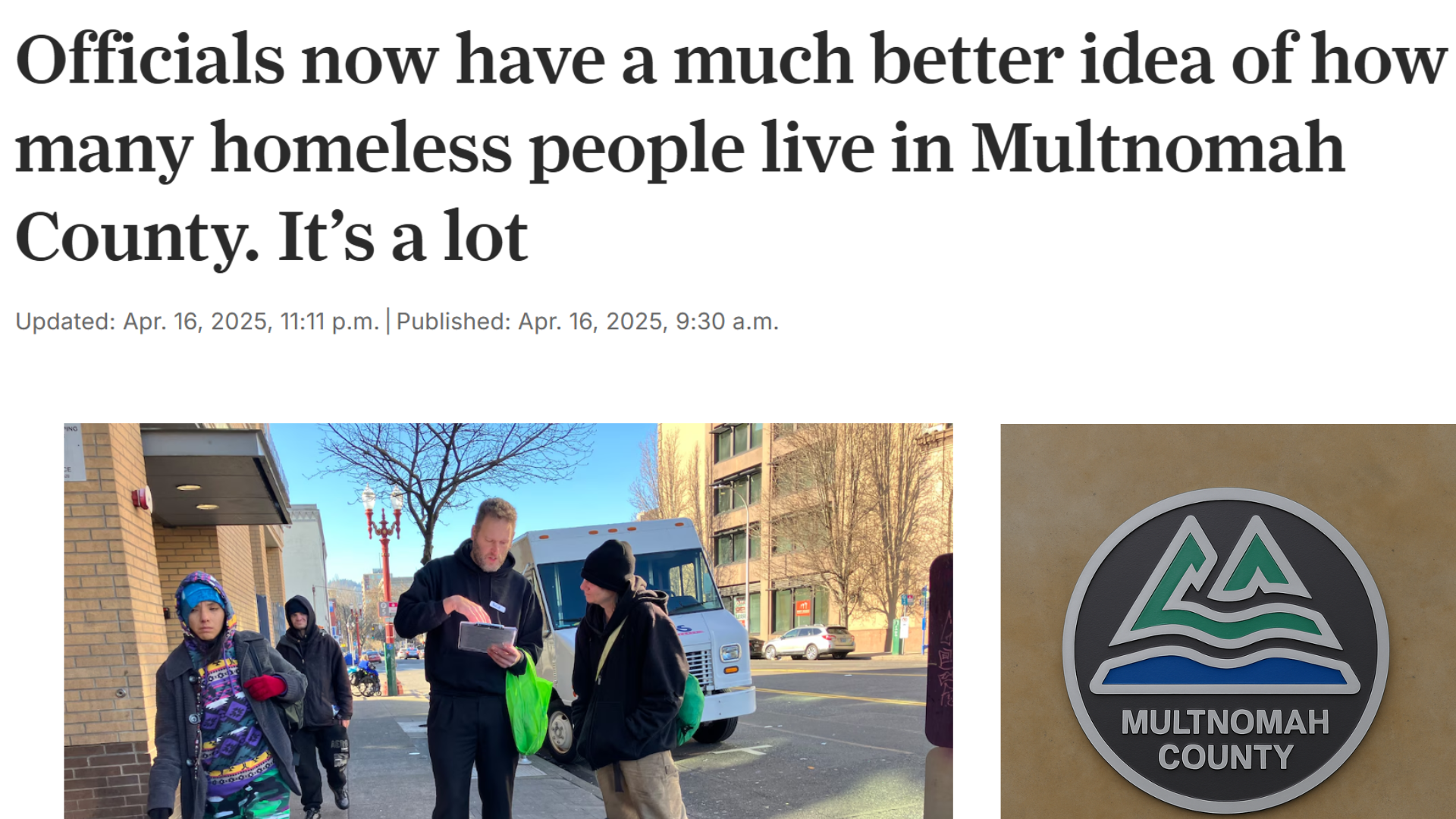Translation: Officials finally learn how to de-duplicate names in their database and realize they still have no idea how many homeless people live in Multnomah County or what to do about it
Link to original Oregonian article by Lillian Mongeau Hughes, published April 16, 2025
The scope and scale of Multnomah County’s homelessness problem is not a “stunning new reality” that’s just been revealed. What’s stunning is how surprised the County seemed to be by the revelation that there are roughly three times as many homeless people on our streets as they’ve previously talked about.
After de-duplicating names and scrubbing data – apparently a first for the JOHS – the latest numbers reveal more than 14,000 people are homeless in Multnomah County. 14,361, to be unexact. That’s 6,796 unsheltered, 4,260 sheltered, and 3,208 unaccounted for.
And… stop right there. 3,208 human beings that the County is supposed to know “by name” are unaccounted for? How is that not the headline? If it’s a by-name list, no one should be unaccounted for. They’re still fudging the numbers.
This is a far cry from a By-Name List.
A By-Name List (BNL) is supposed to be a comprehensive list of every person in a community experiencing homelessness, proactively obtained and updated in real time. The core idea is that you literally go out and identify everyone experiencing homelessness in your community, including their name, location, and needed support services, and put that into a database.
The beauty of having this reliable, accurate, complete, up-to-date list is that it allows governments to strategically invest in building what’s actually needed to end homelessness on a macro scale in their communities, while focusing on meeting the needs of the real human beings living on their streets.
If you can’t account for actual human beings in your database, it’s not a BNL. No matter how many times you say that it is. And the County has said it a lot since City Councillor Dan Ryan and I got the concept adopted in 2020.
- In October 2022, as if by magic, the Joint Office declared it had completed a “quality by-name list” and would soon be releasing numbers.
- In April 2023, the JOHS excitedly reported that it would be releasing its first data to come from its “quality by-name list” of people experiencing chronic homelessness in Multnomah County. They claimed it was “foundational” and a “major milestone”.
- In May 2023, they claimed that 3000 people were living unsheltered in the County.
- In July 2023, the JOHS re-emphasised that the “cornerstone” of their work was building and using a “quality by-name list of individuals experiencing chronic homelessness” and that, thanks to their “quality by-name list”, they could see that “providers funded through the JOHS are rehousing hundreds of people experiencing chronic homelessness.”
- In January 2024, the County said that the total number of people experiencing homelessness according to its “quality by-name list” was 11,153. Of those, 5,398 were unsheltered, 3,197 were sheltered, and 2,558 were unaccounted for. (Again – 2,558 unaccounted for?)
- Last September, I commented in a social media post that the county still hadn’t produced anything like an actual by-name list that proactively identified and comprehensively covered the homeless population. That apparently hit a nerve, because at our next board meeting, the JOHS director accused me of lying when I’d said that the JOHS had not published the number of people actually living unsheltered in our community. He doubled down that the County knew how many people were living unsheltered and that the County had a BNL. “In fact, we published that number earlier this year,” he said. “It’s 5,398.” I shouldn’t have had to remind the director that a BNL, by definition, contains real-time, up-to-date information about the number of people living outside. And that the 5,398 number, which wasn’t accurate even when first reported, certainly wasn’t accurate eight months later.
Now, back to the latest claims.
The numbers may have come as a shock to everyone who hasn’t been paying attention. But the situation is what it’s always been:
- Multnomah County did not have a BNL when it first said it did in 2022, and it still doesn’t.
- The situation is worse than the County has been reporting all along, and the numbers will continue to get worse as they arc toward reality (which is the one silver lining: The numbers do seem to be getting more accurate and more complete).
The most disturbing thing about all of this is that Multnomah County just doesn’t seem to get that this isn’t just about a “list” or about chasing random numbers. It’s about the people at the heart of the list.
The unique value of a BNL comes from linking the numbers to a plan for meeting the needs of the human beings those numbers represent. And nowhere does the County talk about the people behind the numbers, or what the plan is to get them and keep them stably housed. In fact, the Chair’s recently released budget ignores this completely.
This is what the County should be focusing on like a laser, instead of issuing more press releases inaccurately reflecting their efforts to count how many people they’re not serving.
